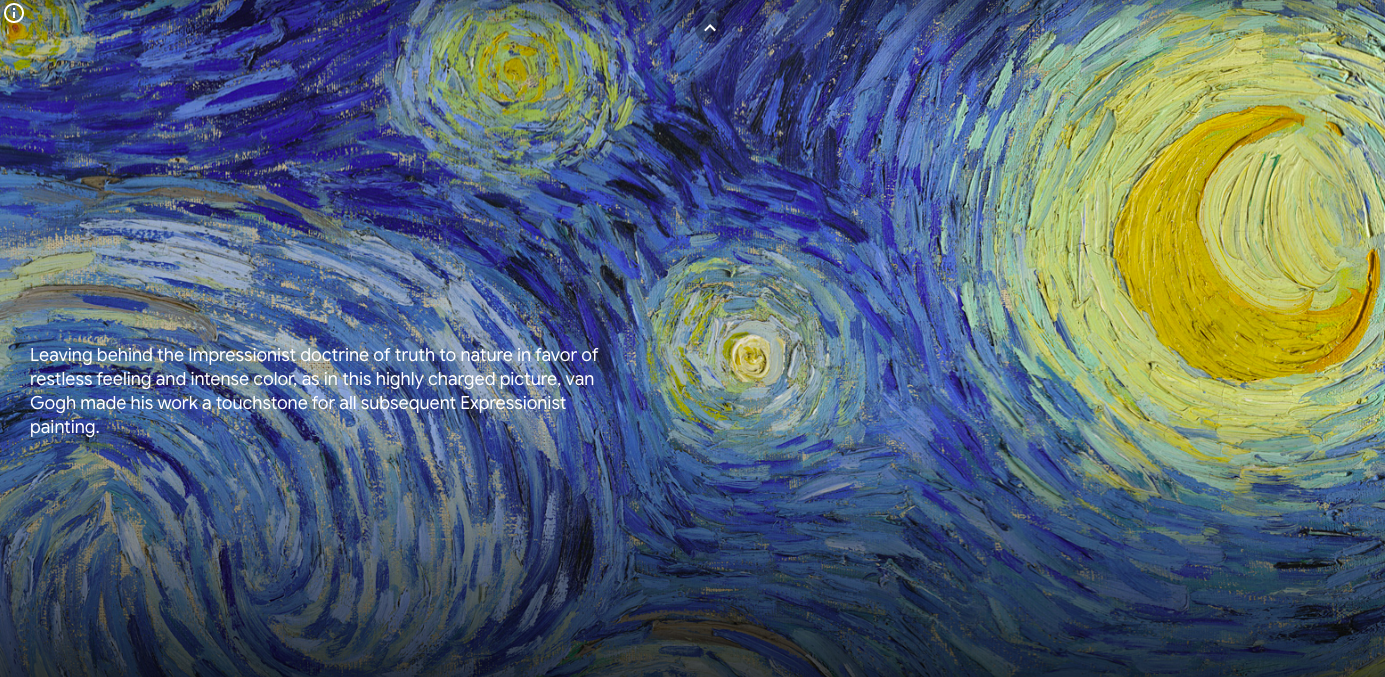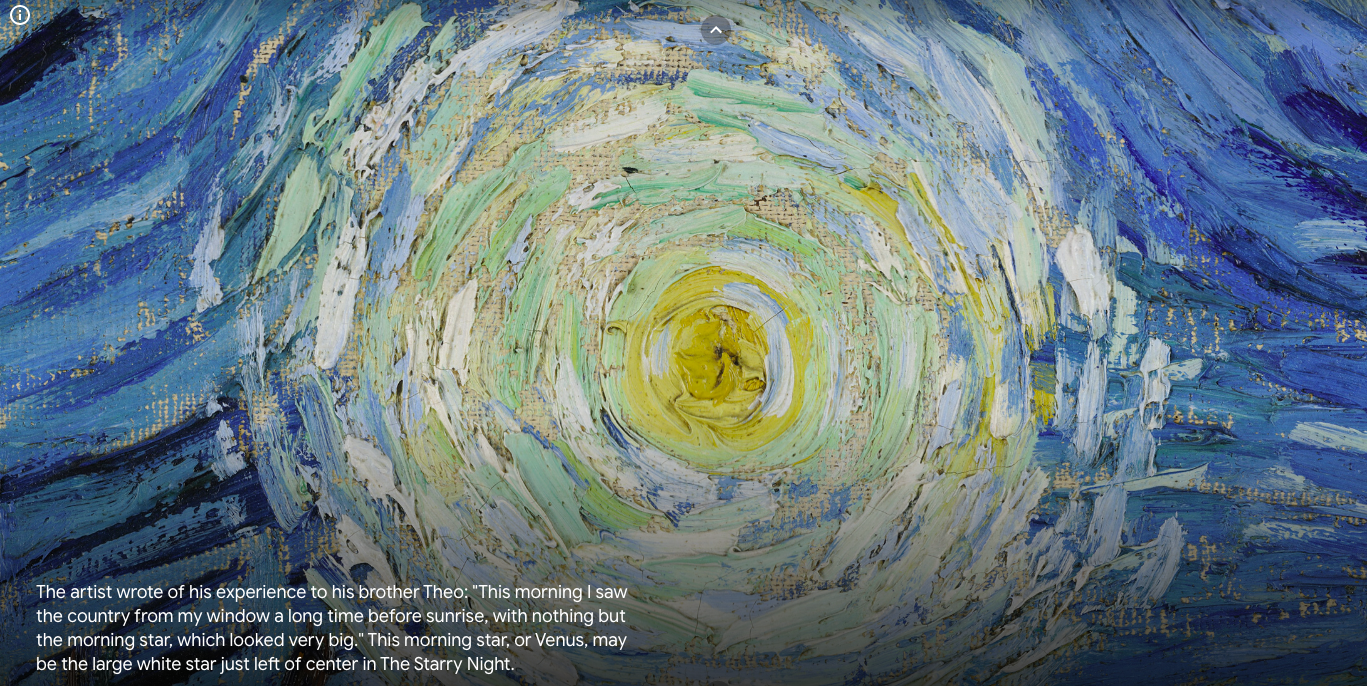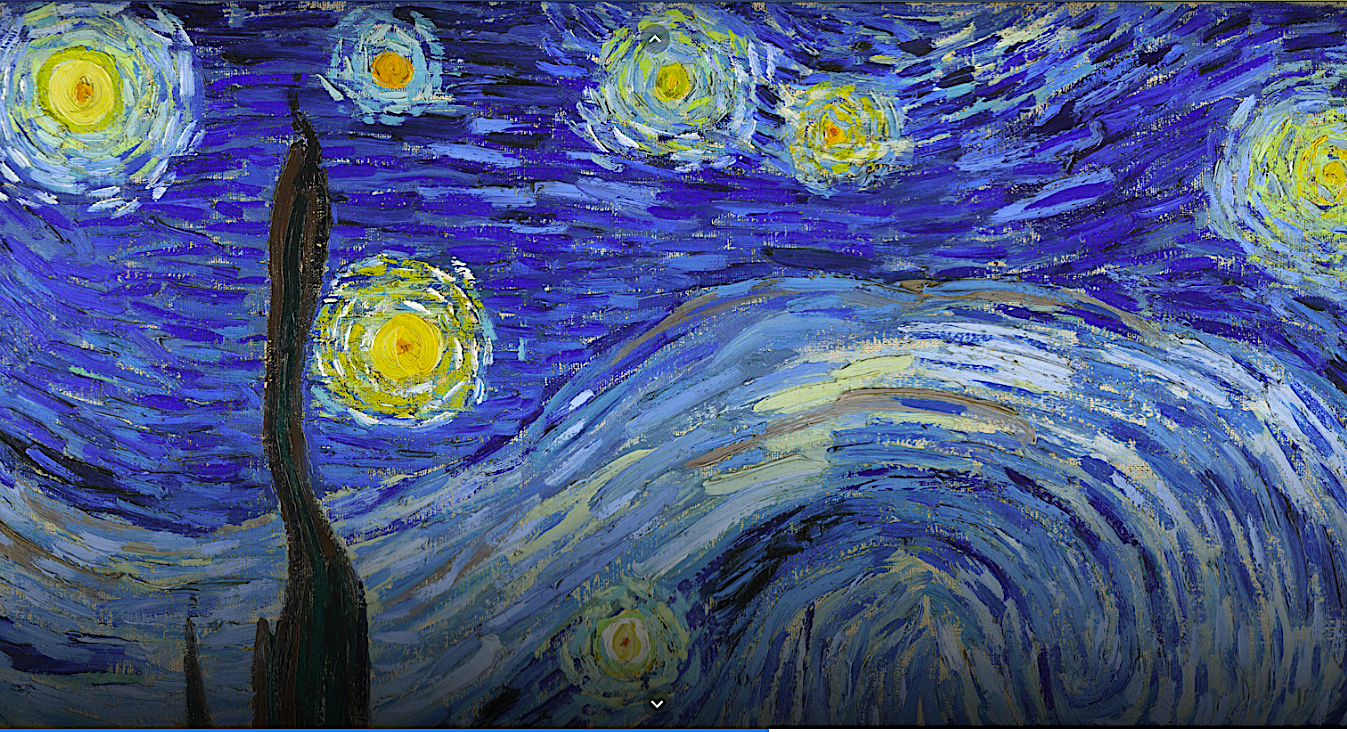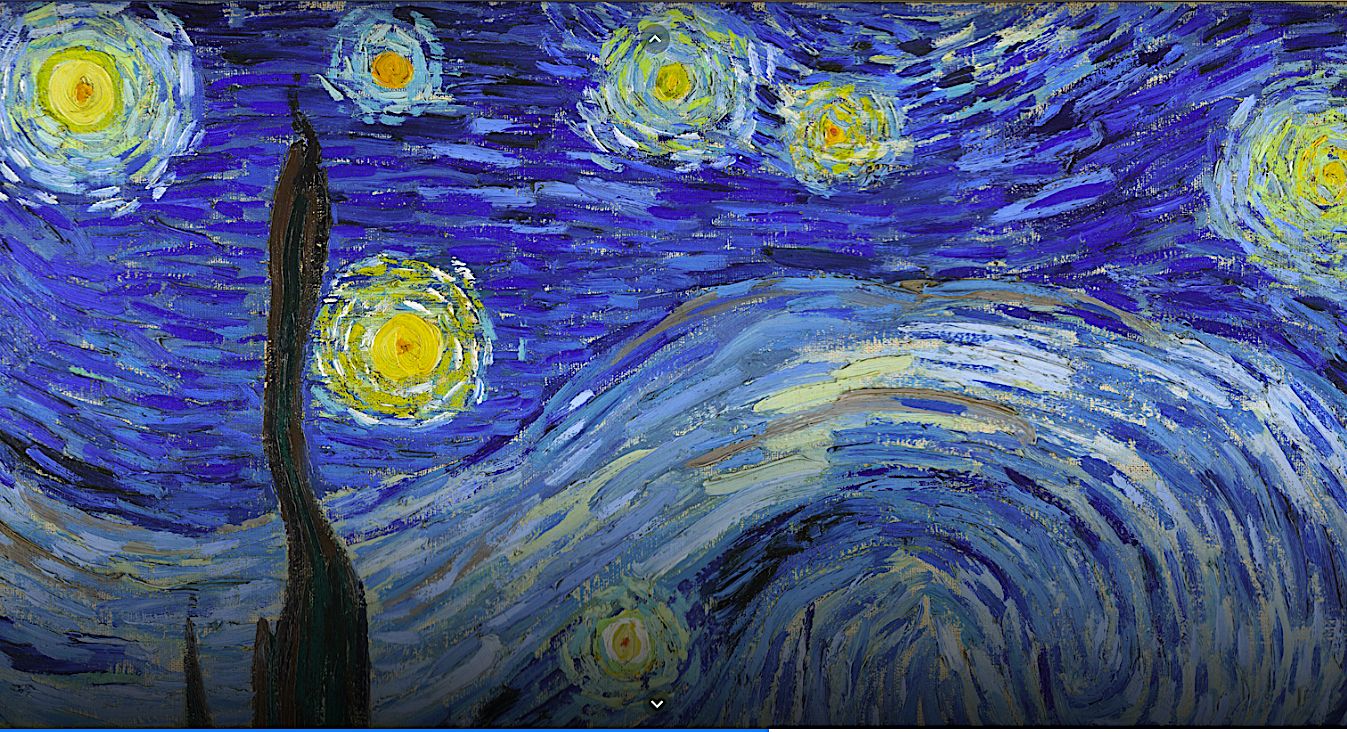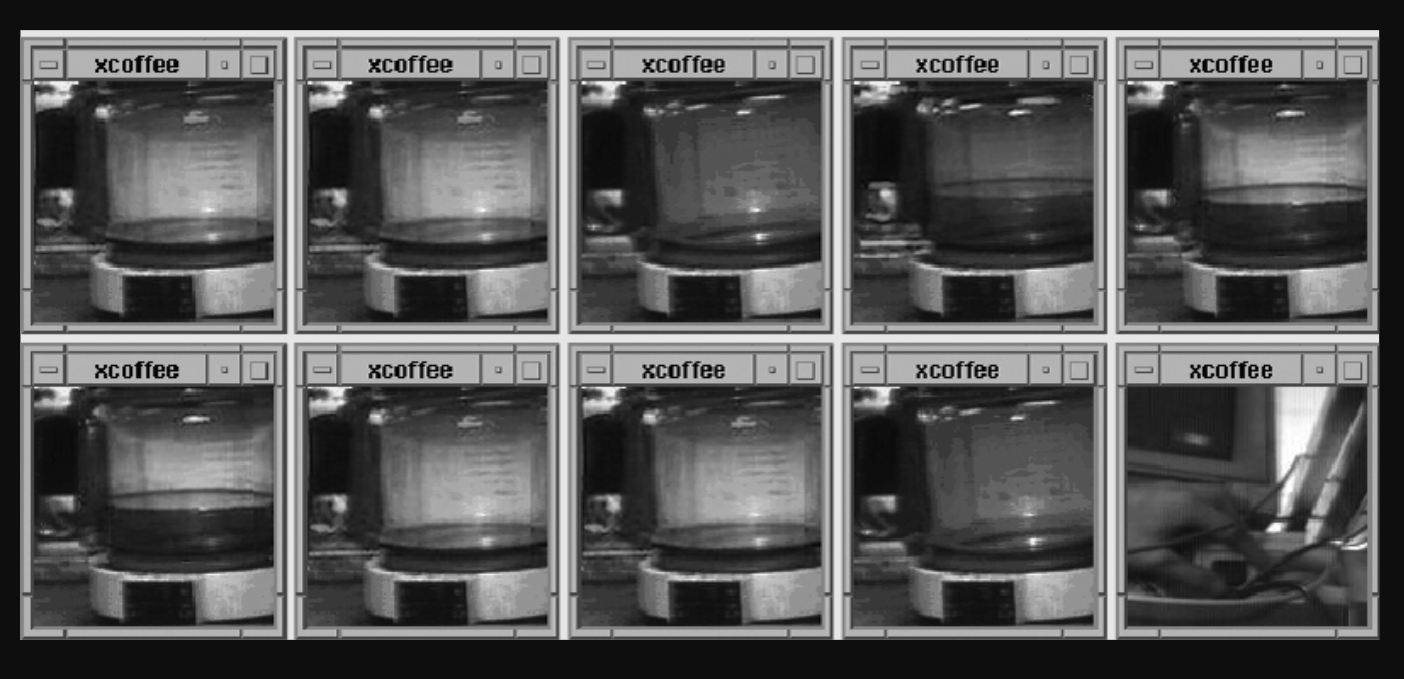[Most Recent Entries] [Calendar View]
Tuesday, September 14th, 2021
| Time | Event |
| 8:00a | Zoom Into a Super High Resolution Photo of Van Gogh’s “The Starry Night”
“Just as we take the train to get to Tarascon or Rouen, we take death to reach a star,” Vincent Van Gogh wrote to his brother from Arles in the summer of 1888:
The following summer, as a patient in the asylum of Saint-Paul-de-Mausole in Provence, he painted what would become his best known work — The Starry Night. The summer after that, he was dead of a gunshot wound to the abdomen, commonly believed to be self-inflicted. Judging from thoughts expressed in that same letter, Van Gogh may have conceived of such a death as a “celestial means of locomotion, just as steamboats, omnibuses and the railway are terrestrial ones”:
Although his window at the asylum afforded him a sunrise view, and a private audience with the prominent morning star he mentioned in another letter to Theo, Starry Night’s vista is “both an exercise in observation and a clear departure from it,” according to 2019’s MoMA Highlights: 375 Works from The Museum of Modern Art:
Those who can’t visit MoMA to see The Starry Night in person may enjoy getting up close and personal with Google Arts and Culture’s zoomable, high res digital reproduction. Keep clicking into the image to see the painting in greater detail. Before or after formulating your own thoughts on The Starry Night and the emotional state that contributed to its execution, get the perspective of singer-songwriter Maggie Rogers in the below episode of Art Zoom, in which popular musicians share their thoughts while navigating around a famous canvas. Bonus! Throw yourself into a free coloring page of The Starry Night here. Related Content: Vincent Van Gogh’s “The Starry Night”: Why It’s a Great Painting in 15 Minutes Ayun Halliday is an author, illustrator, theater maker and Chief Primatologist of the East Village Inky zine. Follow her @AyunHalliday. Zoom Into a Super High Resolution Photo of Van Gogh’s “The Starry Night” is a post from: Open Culture. Follow us on Facebook and Twitter, or get our Daily Email. And don't miss our big collections of Free Online Courses, Free Online Movies, Free eBooks, Free Audio Books, Free Foreign Language Lessons, and MOOCs. |
| 2:00p | What Makes Basquiat’s Untitled Great Art: One Painting Says Everything Basquiat Wanted to Say About America, Art & Being Black in Both Worlds
When Jean-Michel Basquiat’s Untitled (Skull) sold for $110.5 million in 2017 to Japanese billionaire Yusaku Maesawa, the artist joined the ranks of Da Vinci, De Kooning, and Picasso as one of the top selling painters in the world, surpassing a previous record set in 2013 by his mentor Andy Warhol’s work. Untitled dates from 1982, during “the young Basquiat’s mercurial early years,” writes Ben Davis at Artnet, “even before his first gallery show at Annina Nosei, when he was still a Caribbean-American kid from Brooklyn energetically bootstrapping himself into the limelight of the downtown art scene.” It is this period that most interests collectors like Maesawa. Basquiat’s transition from graffiti artist to art world darling was dramatic, celebratory, and self-destructive, all characteristics of his work. But critical primitivism reduced him to a token — an art world attitude saw Basquiats as objects to be stripped of context, turned into decorative badges of authenticity and worldliness. “Maezawa’s head painting possesses a loud, gnashing, and confident aura,” Shannon Lee writes at Artsy. But the artist’s “use of skulls… is deeply rooted in his identity as a Black artist in America. They are strongly evocative of African masks, which have been so fetishized by the art market since modernists like Picasso appropriated them from their native contexts.” But head/skull motifs in Basquiat’s work are not only statements of diasporic Black identity — they emerge through his thematic play of human embodiment, mental illness/health, the competitions of the graffiti world and the headgames of the art world, which Basquiat both mastered and critiqued as a canny outsider. “No subject is more powerful or more sought after in the oeuvre of Jean-Michel Basquiat,” notes Christie’s New York, “than the singular skull.” Though maybe not the most reproduced of Basquiat’s heads, 1982’s Untitled — argues the Great Art Explained video above — exemplifies the themes. At only 22 years old, Basquiat produced “a single painting” that said “everything he wanted to say about America, about art and about being black in both worlds.” So singular is Untitled that it became its own one-painting show in 2018 when its new owner sent it on a tour of the world, beginning in the artist’s hometown at the Brooklyn Museum. Maesawa’s decision to share the painting presents a contrast to the way Basquiat has been treated differently by other owners of his work like Tiffany & Co., who explain their purchase and recent, controversial commercial use of his Equals Pi by citing his “affinity for the company’s statement blue color,” writes Tirhakah Love at Daily Beast — a color they trademarked ten years after Basquiat’s death. The proprietary co-optation of Basquiat’s life and work to sell symbols of colonialism like diamonds, among other luxury goods — and the turning of his work into the ultimate luxury good — debases his purposes. Why show Equals Pi “as a prop to an ad?” asked his friend and former roommate Alexis Adler. “Loan it out to a museum. In a time where there were very few Black artists represented in Western museums, that was his goal: to get to a museum.” Find out in the Great Art Explained video how one of his most famous — and most expensive — works encapsulates that struggle through its vivid color and symbolic visual language. Related Content: The Story of Jean-Michel Basquiat’s Rise in the 1980s Art World Gets Told in a New Graphic Novel Josh Jones is a writer and musician based in Durham, NC. Follow him at @jdmagness
What Makes Basquiat’s Untitled Great Art: One Painting Says Everything Basquiat Wanted to Say About America, Art & Being Black in Both Worlds is a post from: Open Culture. Follow us on Facebook and Twitter, or get our Daily Email. And don't miss our big collections of Free Online Courses, Free Online Movies, Free eBooks, Free Audio Books, Free Foreign Language Lessons, and MOOCs. |
| 7:00p | The Very First Webcam Was Invented to Keep an Eye on a Coffee Pot at Cambridge University The internet as we know it today began with a coffee pot. Despite the ring of exaggeration, that claim isn’t actually so far-fetched. When most of us go online, we expect something new: often not just something new to read, but something new to watch. This, as those of us past a certain age will recall, was not the case with the early World Wide Web, consisting as it mostly did of static pages of text, updated irregularly if at all. Younger readers will have to imagine even that being a cutting-edge thrill, but we didn’t really feel like we were living in the future until the fall of 1993, when XCoffee first went live. This groundbreaking technological project “started back in the dark days of 1991,” writes co-creator Quentin Stafford-Fraser, “when the World Wide Web was little more than a glint in CERN’s eye.” At the time, Stafford-Fraser was employed as one of fifteen researchers in the “Trojan Room” of the University of Cambridge Computer Lab. “Being poor, impoverished academics, we only had one coffee filter machine between us, which lived in the corridor just outside the Trojan Room. However, being highly dedicated and hard-working academics, we got through a lot of coffee, and when a fresh pot was brewed, it often didn’t last long.” It occurred to Stafford-Fraser to train an unused video camera from the Trojan Room on the coffee pot (and thus the amount of coffee available within), then connect it to a computer, specifically an Acorn Archimedes. His colleague Paul Jardetzky “wrote a ‘server’ program, which ran on that machine and captured images of the pot every few seconds at various resolutions, and I wrote a ‘client’ program which everybody could run, which connected to the server and displayed an icon-sized image of the pot in the corner of the screen. The image was only updated about three times a minute, but that was fine because the pot filled rather slowly, and it was only greyscale, which was also fine, because so was the coffee.”
XCoffee, the resulting program, was meant only to provide this much-needed information to Computer Lab members elsewhere in the building. But after the release of image-displaying web browsers in 1993, it found a much wider audience as the world’s first streaming webcam. Stafford-Fraser’s successors “resurrected the system, treated it to a new frame grabber, and made the images available on the World Wide Web. Since then, hundreds of thousands of people have looked at the coffee pot, making it undoubtedly the most famous in the world.” Stafford-Fraser wrote these words in 1995; in the years thereafter XCoffee went on to receive millions of views before its eventual shutdown in 2001. In the Centre for Computing History video above, Stafford-Fraser shows the very Olivetti camera he originally used to monitor the coffee level. (He’d previously worked at the Olivetti Research Laboratory, whose parent company also owned Acorn Computers.) “We could see things at a distance before,” he says. “We could view television programs, we could look through telescopes.” But only after the Trojan Room’s coffee pot hit the internet could we “see what’s happening now, somewhere else in the world,” on demand. Thirty years after XCoffee’s development, we’re mesmerized by live-streaming stars and surrounded by “smart” home appliances, hoping for nothing so much as way to concentrate on our immediate surroundings again — to wake up, if you like, and smell the coffee. Related Content: See Web Cams of Surreally Empty City Streets in Venice, New York, London & Beyond The Coffee Pot That Fueled Honoré de Balzac’s Coffee Addiction Based in Seoul, Colin Marshall writes and broadcasts on cities, language, and culture. His projects include the Substack newsletter Books on Cities, the book The Stateless City: a Walk through 21st-Century Los Angeles and the video series The City in Cinema. Follow him on Twitter at @colinmarshall or on Facebook. The Very First Webcam Was Invented to Keep an Eye on a Coffee Pot at Cambridge University is a post from: Open Culture. Follow us on Facebook and Twitter, or get our Daily Email. And don't miss our big collections of Free Online Courses, Free Online Movies, Free eBooks, Free Audio Books, Free Foreign Language Lessons, and MOOCs. |
| << Previous Day |
2021/09/14 [Calendar] |
Next Day >> |
